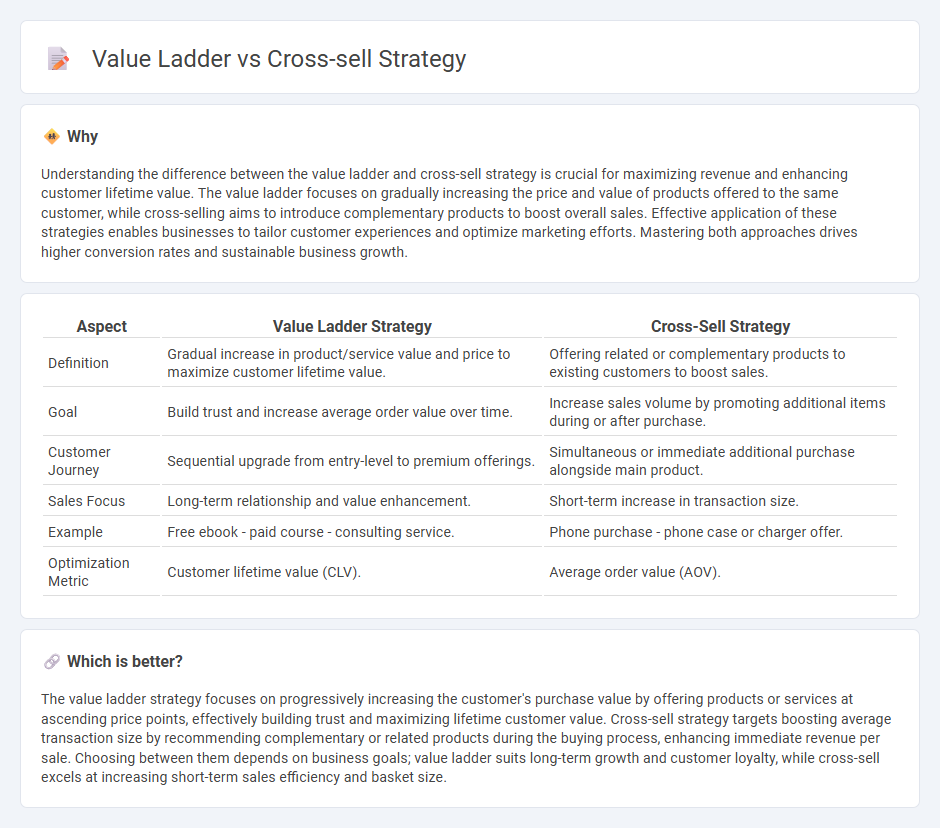
Value ladder strategy focuses on gradually increasing customer investment through sequentially higher-priced products or services, enhancing perceived value and boosting lifetime customer value. Cross-sell strategy aims to offer complementary products or services alongside the primary purchase, maximizing transaction value and improving customer satisfaction. Explore how combining these approaches can optimize your sales performance and revenue growth.
Why it is important
Understanding the difference between the value ladder and cross-sell strategy is crucial for maximizing revenue and enhancing customer lifetime value. The value ladder focuses on gradually increasing the price and value of products offered to the same customer, while cross-selling aims to introduce complementary products to boost overall sales. Effective application of these strategies enables businesses to tailor customer experiences and optimize marketing efforts. Mastering both approaches drives higher conversion rates and sustainable business growth.
Comparison Table
| Aspect | Value Ladder Strategy | Cross-Sell Strategy |
|---|---|---|
| Definition | Gradual increase in product/service value and price to maximize customer lifetime value. | Offering related or complementary products to existing customers to boost sales. |
| Goal | Build trust and increase average order value over time. | Increase sales volume by promoting additional items during or after purchase. |
| Customer Journey | Sequential upgrade from entry-level to premium offerings. | Simultaneous or immediate additional purchase alongside main product. |
| Sales Focus | Long-term relationship and value enhancement. | Short-term increase in transaction size. |
| Example | Free ebook - paid course - consulting service. | Phone purchase - phone case or charger offer. |
| Optimization Metric | Customer lifetime value (CLV). | Average order value (AOV). |
Which is better?
The value ladder strategy focuses on progressively increasing the customer's purchase value by offering products or services at ascending price points, effectively building trust and maximizing lifetime customer value. Cross-sell strategy targets boosting average transaction size by recommending complementary or related products during the buying process, enhancing immediate revenue per sale. Choosing between them depends on business goals; value ladder suits long-term growth and customer loyalty, while cross-sell excels at increasing short-term sales efficiency and basket size.
Connection
The value ladder strategy increases customer lifetime value by offering progressively higher-priced products or services, while cross-sell strategies complement this by promoting related or supplemental items at each step of the ladder. Both approaches drive revenue growth through enhanced customer engagement and higher average transaction sizes. Integrating value ladder frameworks with targeted cross-selling maximizes sales funnel efficiency and deepens customer relationships.
Key Terms
Cross-sell strategy:
Cross-sell strategy targets existing customers by offering complementary products or services to increase average order value and enhance customer lifetime value. Effective cross-selling relies on data-driven insights to identify relevant products that meet customer needs, boosting retention and revenue. Explore how tailored cross-sell strategies can optimize your sales funnel and customer experience.
Complementary Products
Cross-sell strategy emphasizes offering complementary products that enhance the primary purchase, increasing customer satisfaction and average order value. The value ladder builds customer relationships by progressively introducing higher-value products or services, encouraging repeat purchases and loyalty. Explore how integrating complementary products within your cross-sell and value ladder approaches can maximize revenue and customer retention.
Customer Segmentation
Customer segmentation plays a crucial role in differentiating cross-sell strategies from value ladder approaches. Cross-sell strategies target existing customers with relevant complementary products based on their purchase history and preferences, enhancing customer lifetime value. Understanding how to segment your audience effectively empowers tailored marketing efforts and sales tactics--explore more about optimizing these approaches for maximum impact.
Source and External Links
Cross-Selling | Definition + Examples - Wall Street Prep - Cross-sell strategy involves encouraging existing customers to buy complementary products, using methods like product bundling, loyalty programs, point of sale add-ons, and after-sale follow-up campaigns for personalized offers.
10 Expert Cross-Selling Tips for Sales Professionals | Indeed.com - Effective cross-sell strategy tips include limiting recommended products, combining products and services, and creating bundles to encourage customers to purchase additional items beyond their original intent.
What Is Cross-Selling? Intro, Steps, and Pro Tips [+Data] - A cross-sell strategy should be personalized based on customer data and behavior, leveraging tools like AI for timely product recommendations that increase basket size and customer lifetime value.
 dowidth.com
dowidth.com